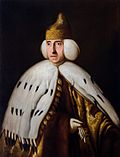| Doge of Venice | |
|---|---|
 Coat of arms | |
| Style | His Serenity |
| Residence | Palazzo Ducale |
| Appointer | Serenissima Signoria |
| Formation |
|
| First holder |
|
| Final holder | Ludovico Manin |
| Abolished | 12 May 1797 |
| Salary | 4,800 ducats p.a. (1582)[1] |
The Doge of Venice (/doʊdʒ/ DOHJ)[2][a] was the highest role of authority within the Republic of Venice (697 CE to 1797 CE).[3] The word Doge derives from the Latin Dux, meaning "leader," originally referring to any military leader, becoming in the Late Roman Empire the title for a leader of an expeditionary force formed by detachments (vexillationes) from the frontier army (limitanei), separate from, but subject to, the governor of a province, authorized to conduct operations beyond provincial boundaries.
The Doge of Venice acted as both the head of state and head of the Venetian oligarchy. Doges were elected for life through a complex voting process.[4]
- ^ Frederic C. Lane, Venice, A Maritime Republic (JHU Press, 1973), p. 324.
- ^ "doge". Dictionary.com Unabridged (Online). n.d. Retrieved 9 July 2018.
- ^ "Republic of Venice | Map and Timeline".
- ^ "The Doge".
Cite error: There are <ref group=lower-alpha> tags or {{efn}} templates on this page, but the references will not show without a {{reflist|group=lower-alpha}} template or {{notelist}} template (see the help page).
